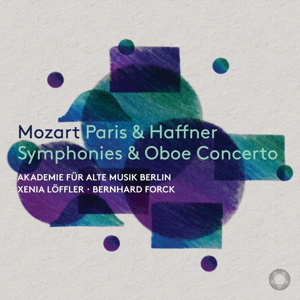
Wolfgang Amadeus Mozart (1756-1791)
Symphony in D Major, K. 385 ‘Haffner’ (1783)
Harmoniemusik: Overture to Die Entführung aus dem Serail (1782)
Oboe Concerto in C Major, K. 271k/K. 314 (1777)
Symphony in D Major, K. 297/300a ‘Paris’ (1778)
Xenia Löffler (oboe)
Akademie für Alte Musik Berlin/Bernhard Forck
rec. live, 27-29 September 2022, Kulturstall Britz, Alt-Britz, Berlin, Germany
Booklet with commentary in German and English included
Pentatone PTC5187059 [65]
The statement on the back cover does not indicate how comprehensive this series of Wolfgang Amadeus Mozart’s symphonies will be or when it will reach completion. If the forthcoming instalments maintain the standard of the first release, then venerable period-instrument sets will have serious and welcome competition because the Akademie für Alte Musik Berlin have synthesised adventure and sophistication into exciting performances that avoid routine without resorting to pretentious gestures. Christopher Hogwood’s pioneering cycle with the Academy of Ancient Music (1979-1985) included all of the symphonies and alternative versions thereof that could then be attributed to Mozart, while Trevor Pinnock’s collection with the English Concert (1992-1995) featured refined playing, but fewer works.
The present disc opens with a rousing performance of the Symphony in D Major, K. 385 ‘Haffner’. Its rhythmically taut opening movement is a refreshing contrast to Frans Brüggen’s (1985) flaccid account with the Orchestra of the Eighteenth Century included in Mozart 225: The New Complete Edition. The ‘Andante’, which rightly includes all of the repeats, proceeds at an ideal moderate tempo. The ‘Menuetto’ exudes a dance-like, lilting quality despite its swift, staccato opening. The final ‘Presto’ proceeds briskly without sacrificing clear articulation.
In his own academies, Mozart presented several facets of his output by including a symphony, a concerto, some arias, and perhaps improvisation at the keyboard. This disc is varied in terms of the genres in which Mozart composed: the two symphonies are separated by the overture to the Singspiel from Die Entführung aus dem Serail (1782) in the ‘Harmoniemusik’ (i.e., wind instrument) arrangement and the Oboe Concerto in C Major (1777). Mozart adapted the opening theme to the concerto’s final movement as Blonde’s second-act aria ‘Welche Wonne, welche Lust Herrscht nunmehr in meiner Brust!’. This parallel could have been illustrated by including the ‘Harmoniemusik’ arrangement of this aria.
Xenia Löffler’s lithe performance of the Oboe Concerto in C Major, K. 271k/K. 314, emphasises how the instrument resembles a singing voice in phrases flowing together seamlessly and inevitably in a passionate narrative. Löffler ranks among the finest period-instrument accounts, including the 1999 recording by Hans Peter Westermann with Concentus Musicus Wien under Nikolaus Harnoncourt’s direction.
Composed in Paris in 1778, the three-movement Symphony in D Major, K. 297/300a, receives a vivacious performance from the Akademie für Alte Musik Berlin with expressive warmth on eighteenth-century instruments equal to what modern orchestras can achieve. The revised ‘Andante’ that Mozart composed at the behest of Joseph Legros, who commissioned the symphony, makes a valuable appendix. Since it derives from a concert performance, it would have been desirable to use the remaining space on the CD for another complete performance so that the alternate movement could be heard in context without having to skip back and forth with a remote control.
Pentatone’s initial volume augurs well for what hopefully will become a series encompassing all of the extant orchestral music that Mozart is known to have written. It addresses one challenge posed by recorded media, which can shape our listening habits. Neither Mozart nor any of his contemporaries intended for their symphonies to be played one after another, but this is how most CD box sets present the music. Interspersing the symphonies with other works increases concentration on each individual piece. By departing from the precedent of issuing three to five symphonies on a disc, this release follows a pattern somewhat like a late eighteenth-century concert.
Roman Hinke’s six-page essay in the accompanying booklet is a scholarly introduction to the music. As with many recent releases by Pentatone, the CD is stored in a plastic tray glued into the left side of a cardboard diptych with the booklet attached to the right panel. A standard jewel case, which provides superior protection for the disc and documentation, would be preferable for this exemplar of first-rate music making.
Daniel Floyd
Help us financially by purchasing from





















